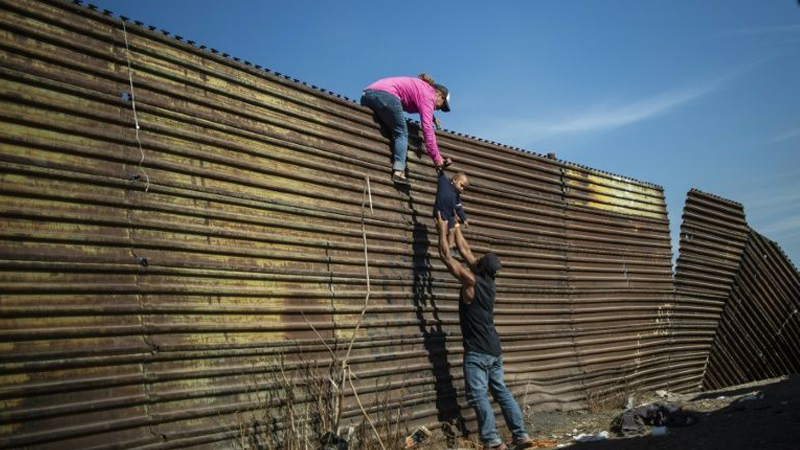 From the Central American caravans trekking desperately northward to the mass exodus from Venezuela, 2018 was the year the migration crisis swept the Americas and reached the doorstep of the United States.
From the Central American caravans trekking desperately northward to the mass exodus from Venezuela, 2018 was the year the migration crisis swept the Americas and reached the doorstep of the United States.
Scenes of Syrian and African refugees risking their lives to reach Europe’s shores had their New World equivalent this year in the masses of Central Americans who traveled more than a month to the US-Mexican border, many carrying young children or pushing them in strollers.
Playing to the same anti-immigrant sentiment leveraged by Europe’s far right, President Donald Trump called it an “invasion,” sought to overhaul US asylum policy and deployed thousands of troops to the border.
Among the lasting images of 2018 are seas of dogged migrants walking in flip-flops or flimsy plastic shoes; crying children taken from their parents and held in cage-like enclosures under the Trump administration’s since-abandoned practice of separating undocumented families; and hundreds of desperate migrants rushing the US-Mexican border, only to be battled back with tear gas.
Latin Americans have long migrated to the United States — half a million Central Americans cross Mexico each year to chase their American dreams — but they used to do it in secret.
This was the first time the US had confronted such a large, visible influx of Central Americans, as people fleeing poverty and violence used social media to organize themselves into caravans, seeking protection from kidnapping, extortion and murder by crime gangs that prey on migrants.
For Trump, it played into his political message at the height of an election season.
“If you want to protect criminal aliens — VOTE DEMOCRAT. If you want to protect Law-Abiding Americans — VOTE REPUBLICAN!” he tweeted on November 3, three days before the US midterm elections.
Trump’s party lost control of the House of Representatives in the elections — though it gained seats in the Senate, enabling him to claim his nationalism had resonated with voters.
Facing a new political reality, Trump has threatened to partly shut down the federal government by refusing to sign a spending bill if Congress does not give him $5 billion to build his much-wanted border wall.
American Christmas
For the migrants now stuck on the border, the choices are bleak: join the huge lines to enter the United States legally and file long-shot asylum applications; sneak across and hope for the best; settle in Mexico; or go home.
In Tijuana, across the border from San Diego, California, Honduran migrant Elvin Perdomo — one of the more than 7,000 people who joined the largest caravan at its height — looks longingly at the other side.
“There’s nothing in the world I want more than to spend Christmas over there, with my family and a roof over my head,” he told AFP.
Perdomo, 32, traveled 4,300 kilometers (nearly 2,700 miles) to get here, but does not know what to do next.
Other groups of migrants also found few options at the border.
The first to face Trump’s fury — the “Migrant Way of the Cross” launched in March — dissipated as participants realized they had little chance of gaining asylum in the United States.
Organized by activists every year around Easter to raise awareness about the plight of migrants, that caravan used to draw a few hundred people.
This year — whether in spite of Trump or because of him — it drew 1,500, and inspired the larger caravans that followed.
But despite their numbers, such caravans inevitably run into the reality of outmoded asylum policies adopted in the wake of World War II, said Dolores Paris Pombo, a migration expert at the College of the Northern Border, in Tijuana.
The 1951 Refugee Convention signed in Geneva mainly addresses political, ethnic and religious persecution.
But “there is a very large flux of people now migrating because of emergency situations caused by other inter-related factors, such as poverty, violence and climate change,” she said.
Venezuelan exodus
In South America, the number of Venezuelans fleeing the country’s economic and political implosion meanwhile swelled to 2.3 million since 2015.
The once-wealthy oil-producing country has veered toward the brink of collapse under leftist President Nicolas Maduro, who won a new six-year term in May in a widely condemned election marred by irregularities.
The exodus of Venezuelans has stoked tension across the region.
In Brazil, an angry mob in the border town of Pacaraima set fire to Venezuelan migrant camps in August, chasing out 1,200 people.
In Peru, where 600,000 Venezuelans have fled, the government last month began requiring passports for those who would follow them.
A court blocked a similar measure in Ecuador.
Carmen Fuenmayor, 57, a teacher, joined the exodus but returned to Venezuela after nine months struggling to find work.
She will spend Christmas alone this year. Her daughters are still in Ecuador.
“They have their lives. I decided mine was here in Venezuela,” she said.
Published in Daily Times, December 14th 2018.